7. Techniques to reinforce tunnel linings using FRP plates
- The RTRI developed an inner-surface reinforcement method for tunnel linings using FRP plates.
- Reinforcement can be performed with almost no reduction in the space inside the tunnels.
- The RTRI also confirmed outstanding reinforcement effects/workability and presented basic specifications.
Although various construction methods can be adopted for the repair and reinforcement of mountain tunnels, the fibre sheet adhesion method (which rarely reduces the internal space of tunnels) has recently become widely used, mainly because it counters spalling. However, it also has drawbacks, including the possible peeling of the fibre sheet before the adhesive hardens and the difficulty of inspecting the tunnel surface.
Accordingly, the RTRI developed a fibre-reinforced plastic (FRP) plate adhesion method (Fig. 1) that offers superior performance in terms of workability, safety until adhesive hardening, and ease of maintenance with the low impact on internal space reduction. The effects of reinforcement were confirmed in model experiments using 1:5 scale tunnel linings, and included, for example, an increase of 50% in allowable deformation before bending compressive fractures (compressive cracking) occur (Fig. 2)
RTRI also performed test construction work in a dead-track tunnel with a brickwork lining and demonstrated excellent levels of workability. The results included a reduction in work time of about 25% compared with that of the fibre sheet adhesion method and favourable conformity to substrate irregularities (Fig. 3). Accordingly, basic specifications for the technique were presented.
 Fig. 1 Outline of the FRP band plate adhesion method
Fig. 1 Outline of the FRP band plate adhesion method
 Fig. 3 Situation of test construction work
Fig. 3 Situation of test construction work Fig. 2 Situation of model experiment and effects of reinforcement
Fig. 2 Situation of model experiment and effects of reinforcement